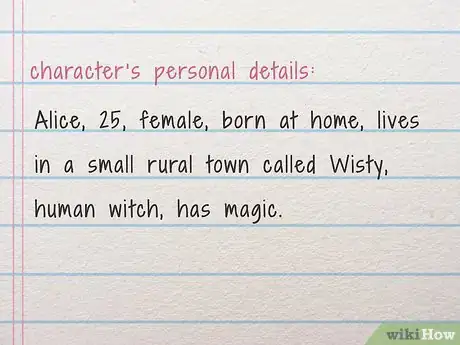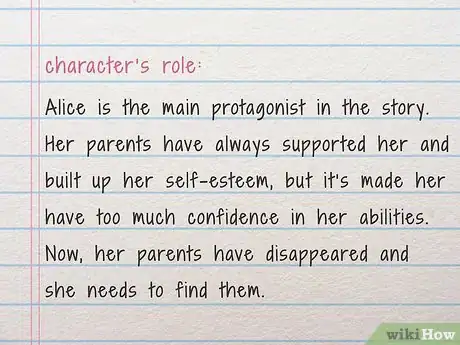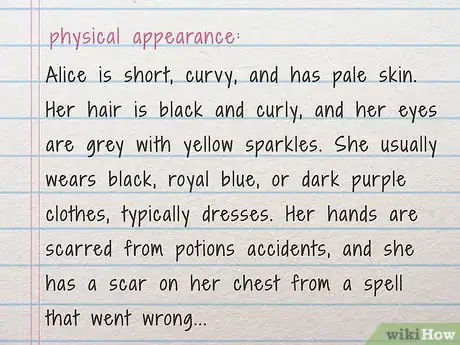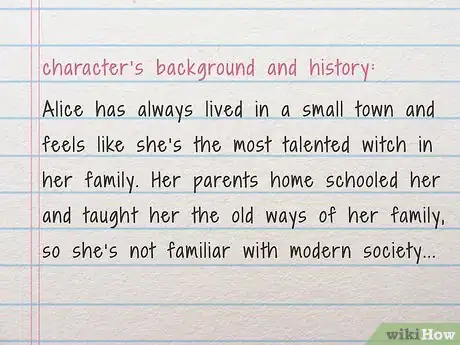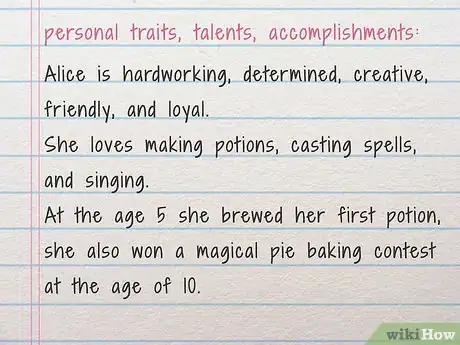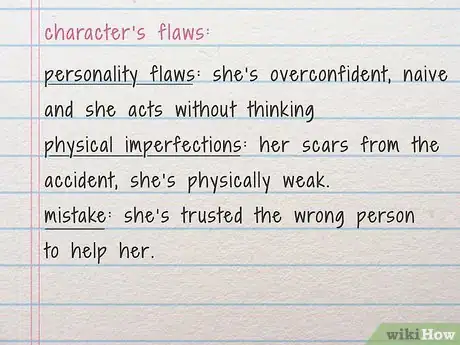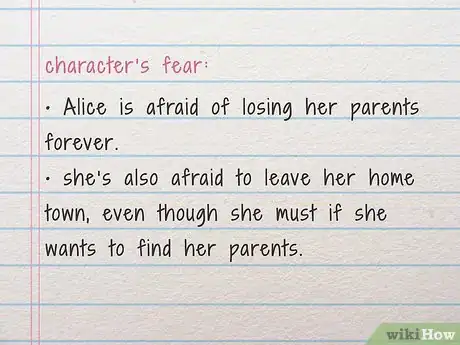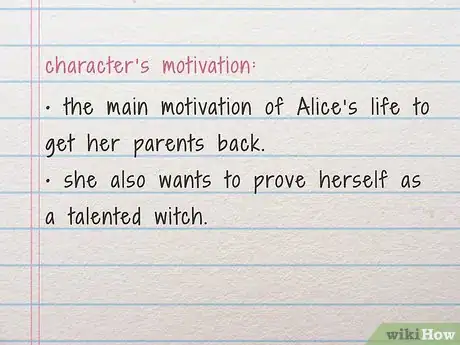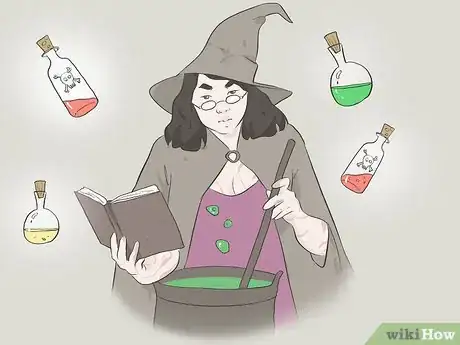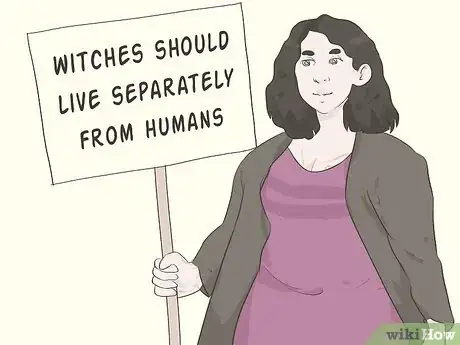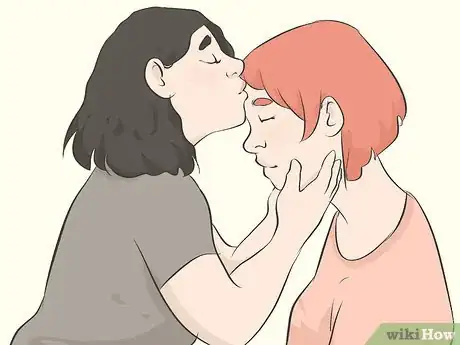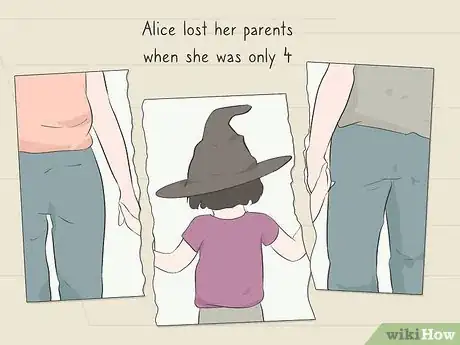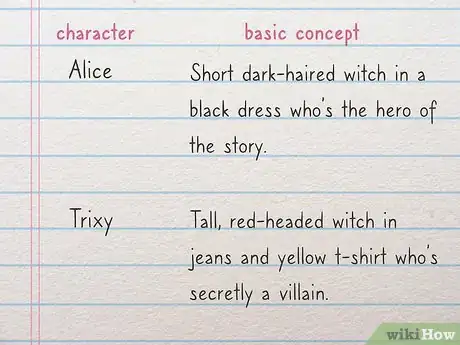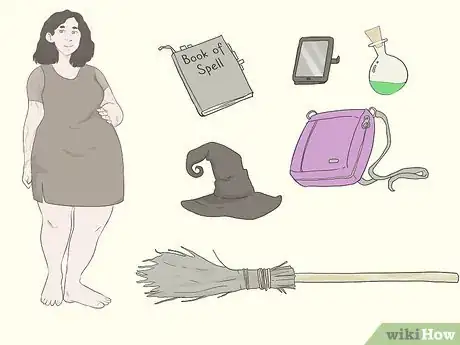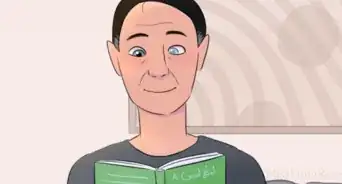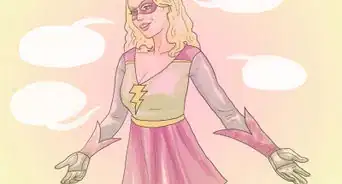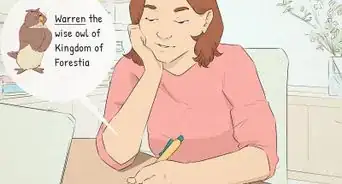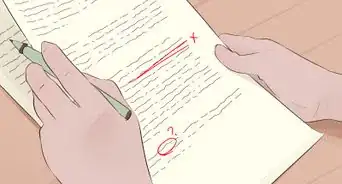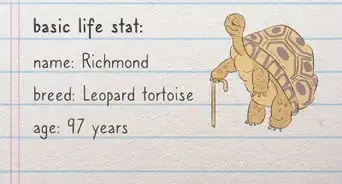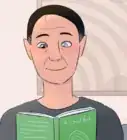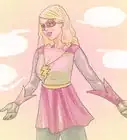This article was co-authored by Lucy V. Hay and by wikiHow staff writer, Danielle Blinka, MA, MPA. Lucy V. Hay is an author, script editor and blogger who helps other writers through writing workshops, courses, and her blog Bang2Write. Lucy is the producer of two British thrillers and her debut crime novel, The Other Twin, is currently being adapted for the screen by Free@Last TV, makers of the Emmy-nominated Agatha Raisin.
There are 7 references cited in this article, which can be found at the bottom of the page.
wikiHow marks an article as reader-approved once it receives enough positive feedback. In this case, 82% of readers who voted found the article helpful, earning it our reader-approved status.
This article has been viewed 414,896 times.
You might want to create an original character (OC) for a story, novel, comic book, or other creative project. Coming up with a character who’s unique and real can be a big challenge, but there are some techniques for helping you through the process. A great way to create complex, well-developed characters is to make a character sheet. Additionally, you can flesh out your character as you write them in scenes. When drawing your character, do several practice sketches to work out the details, then create your final drawing.
Steps
Completing a Character Sheet
-
1Write your character’s personal and biographical details at the top. This includes their name, age, birth place, where they live, and their basic personal details, such as their species and sex or gender if they have one. List as many details that you can think of right now. It’s okay if you don’t know everything yet.[1]
- You could write, “Alice, 25, born at home, lives in a small rural town called Wisty, human witch, female, has magic.”
- If you’re not sure about a detail, leave a blank space for it so that you can come back later. Sometimes it takes time to really understand a character.
Tip: You can create your own character sheet or use a template, which you can find online.
-
2Explain the character’s role in the story. Every character should have a function in the story you’re telling.[2] Consider what your OC is going to contribute to the story, then assign them a basic role. It’s okay if you go back and change this later, but it’s good to have an idea.
- For instance, your character might be the hero, the villain, the femme fatale, the wise elder, the romancer, or the helper. As an example, a female character who uses her looks to hide the fact that she’s a dangerous thief might be a femme fatale.
- It’s okay if your character has more than 1 role. For instance, a male character who falls in love while rescuing a city might be both a hero and a romancer.
Tip: Put your own spin on traditional character archetypes, such as the chosen one, the hero, the anti-hero, the villain, the mentor, the caregiver, the orphan, the seductress, the lover, the innocent, or the loner. Pick an archetype that works for your character, but add unique traits that make your character original.
Advertisement -
3Describe your character's physical appearance in a list or paragraph. Ask yourself how your character will look. Then, describe their basic physical features, how they typically dress, and how they move and stand. Be as detailed as you want to be at this stage. You can always add more details later.[3]
- You might write, “Alice is short, curvy, and has pale skin. Her hair is black and curly, and her eyes are grey with yellow sparkles. She usually wears black, royal blue, or dark purple clothes, typically dresses. Her hands are scarred from potions accidents, and she has a scar on her chest from a spell that went wrong. She’s proud of her witch heritage, so she always stands up straight and walks with her chin slightly lifted.”
-
4Explain your character’s background and history. Describe your character's past and how it’s brought them to this point in the story.[4] Discuss what they’ve done as well as things that have happened to them. Include the major details that shaped them as a character.[5]
- For instance, “Alice has always lived in a small town and feels like she’s the most talented witch in her family. Her parents home schooled her and taught her the old ways of her family, so she’s not familiar with modern society. She’s always tried really hard to learn new spells, to the point that she annoyed her family members. Her parents have always supported her and built up her self-esteem, but it’s made her have too much confidence in her abilities. Now, her parents have disappeared and she needs to find them, but her overconfidence is causing her to make mistakes.”
-
5List your character’s personal traits, talents, and accomplishments. Think of 5-10 traits that are really important to your character. Include the talents they might possess, like singing, running fast, or casting spells. Then, consider what types of achievements they might make, as well as what would make them proud.[6]
- Decide their overall attitude. For instance, are they an optimist, a pessimist, or a realist?
- Alice’s personal traits might include that she's hardworking, determined, quick thinking, creative, friendly, and loyal. Her talents might include making potions, casting spells, and singing. For achievements, you might include that she brewed her first potion at age 5, she won a magical pie baking contest, and she’s the rightful possessor of her family’s spell book.
Tip: Give your character a quirk that shows your audience something about their personality. For instance, Alice might have a habit of flicking her wrist when she talks because she's so used to doing spells.
-
6Explain your character’s flaws so they seem more real. It’s tempting to make your character perfect, but this makes them seem fake. Everyone has flaws, so consider what your character’s flaws might be.[7] This can include bad personality traits, physical imperfections, or mistakes that they’ve made. Describe these flaws in your character sheet.[8]
- Alice’s personality flaws might include being overconfident, being naive, and acting without thinking. Her physical imperfections might include her scars, the fact that she runs slowly, and the fact that she’s physically weak. Her mistake might be that she’s trusted the wrong person to help her.
-
7Give your character a fear that might become an obstacle. Everyone is afraid of something, so fear helps make your character more real. Additionally, it gives you something to threaten them with in a story.[9] Identify what might scare your character the most and include it on their character sheet.[10]
- For instance, Alice might be afraid of losing her parents forever. Additionally, she may be afraid to leave her home town, even though she must if she wants to find her parents.
-
8Determine your character’s motivation or what they want. Every character needs to have a motivation, which is typically tied to what they want. This is what drives the story forward. Think about what your character would logically want most, then explain this in your character sheet.[11]
- If you already know the plot of your story, use this to figure out your character’s motivation. What is the core conflict in your plot? What is your character missing? This is likely their motivation.
- In Alice’s story, her motivation might be to get her parent’s back. Additionally, she probably wants to prove herself as a talented witch.
Fleshing out Your Character
-
1Ask your character questions to create character development. Make a list of questions you could ask your character, or look for a list online. Then, go through the list and answer each question as your character. Base the answers on your character’s background, their personality, and what they want.
- Questions might include, “What’s your favorite food?” “Do you have a pet?” “What is your relationship like with your family?” “Where do you see yourself in 5 years?” “What is your earliest memory?” “What is your dream job?” “Who is your most trusted confidant?” and “What’s in your bedroom?”
- As an example, Alice might say that her favorite food is homemade kettle corn because she likes the salty-sweet taste. She might also say that she has a black cat and an orange cat that act as her familiars.
-
2Create a unique voice that reflects your character's persona. Give your character an accent or speech pattern that shows their background or personality. Additionally, use words and sentence structures that reflect your character's level of education and place in society. This will help your audience learn more about your character through their speech.[12]
- As an example, Alice might include old fashioned words in her speech and may occasionally rhyme due to her experience making spells. She might say things like, "The forest has darkened a wee bit early, but that's no reason for you to get surly."
-
3Show your character in everyday situations to portray their personality. You can learn a lot from a person by watching how they go about their life. This includes activities like cooking, eating, cleaning, driving a car, or talking to a receptionist. Explore how your character acts in these moments to help their character development.[13]
- For instance, Alice might clean her house and cook her breakfast using a spell. Then, you might have her struggle to purchase items at a store because she can’t use her magic there. This shows that she overly relies on her magic.
- As another example, you might show Alice trying to check out a magic book from the library. She might blush and mumble when she talks to the clerk and have trouble making eye contact. This shows that she’s shy.
-
4Make your character take a stance on an important issue. Real people have opinions, so your character should, as well. Consider which issues in your story will be most important to your character. Then, decide what your character’s opinion on that issue would be. Use this opinion to help with character development.
- For instance, Alice might believe that witches should live separately from non-magical humans. This might make it hard for her to work with humans. Additionally, it might create conflict between her and other witches.
-
5Develop your character’s relationship with other characters in the story.[14] Show your character interacting with their family, friends, or an antagonist. Make sure that each character is distinctive so that you see the similarities and differences between them. This helps you better understand what your OC is about and who they really are.[15]
- As an example, Alice might have a girlfriend named Lilly. Her and Lilly love each other, but can't agree on certain things, causing them to argue. Lilly doesn't have a lot of faith for the relationship. However, Alice is set on making the relationship work. This might convey that Alice is determined to make things work with people she cares for.
- As another example, let’s say Alice has a best friend named Trixy. You might have a scene where Alice and Trixy come across an injured witch in the woods. Alice might stop and help the witch, offering him her last bit of water and food. Trixy might roll her eyes and tell Alice that she’s wasting her time by helping. Then, Trixy might go to get help but return really late because she took a break to do something fun. This shows that Alice is kind and helpful, while Trixy might be unreliable.
-
6Take something away from your character to build tension. To make your story interesting, you have to give your character problems and deny them what they want. Create obstacles and losses for your character that keeps them striving to get what they want. This helps them develop as a character and keeps your audience rooting for the character.[16]
- For example, Alice might almost find her parents but them they get moved again. Similarly, she might realize that her best friend Trixy is secretly helping the person who took her parents.
Drawing Your Character
-
1Create your character sheet or a basic concept first. Make sure you have a basic overview of your character before you start to draw them. Ideally, complete a character sheet so you know exactly who they are. If you don’t want to be this detailed, decide their role in the story and their basic physical traits.[17]
- A basic concept for Alice might be, “Short dark-haired witch in a black dress who’s the hero of the story.”
- For Trixy, you might write, “Tall, red-headed witch in jeans and yellow t-shirt who’s secretly a villain.”
-
2Choose a distinctive posture for your character. How your character stands says a lot about their personality. Think about how your character would hold their body based on their personality and goals. Then, picture what their silhouette would look like. Use this to create an outline of your character.[18]
- For example, Alice might be standing tall with her hand on her hip and her nose pointed in the air.
- Trixy, on the other hand, might be looking down and off to the side. Her hands might pressed together in front of her body to show that she’s hiding something.
-
3Make several sketches of your character to find the look you want. Quickly sketch out the basic look you’re going for with this character. Do a couple of sketches so you can try different details and angles. Then, review your sketches to help you decide how you want to draw the character.[19]
- Sketching also helps you warm up so it’s easier to draw.
- Don’t worry about making mistakes. These sketches should be loose and don’t need to be finished.
Tip: Sketch your character from different angles to create a more complete look.
-
4Add clothing and accessories that reflect your character’s personality. What your character wears should show something about them as a character. This includes the type of clothing they wear, the colors they pick, and the accessories they choose. Think about how your character would dress, then create an outfit that works for them.[20]
- For example, Alice might wear flowing dresses because she thinks it better reflects her witch heritage. Similarly, she might stick to dark colors because it makes her feel witchy. For accessories, she might wear an old locket that has her grandmother’s picture in it.
- Trixy might wear modern clothes because she doesn’t follow the old ways. Additionally, she might choose bright colors because it makes people think she’s happy, even though she’s not. For accessories, she might carry a purse that’s made from a pet fox that she once had.
-
5Draw your character based on your sketches. Now that you’ve decided on the posture and basic physical features, create a drawing of your character. Do this on paper or your computer, depending on what’s comfortable for you. Make this drawing as detailed as you’d like.
- You might be able to use a drawing app to help you create your character.
- If you’re using the drawing as inspiration but don’t plan to show it to people, don’t worry if it’s not perfect. Just do your best.
- If you’re creating a comic book or something similar, practice drawing your character over and over. This will help you get good at it, so don’t give up!
Sample Character Descriptions
Community Q&A
-
QuestionDoes the character have to be in a fandom?
 Community AnswerNo, it can be in your own original story. If you do make a completely original character, do your best to avoid copying any characters from a fandom.
Community AnswerNo, it can be in your own original story. If you do make a completely original character, do your best to avoid copying any characters from a fandom. -
QuestionCan I take inspiration from other existing characters?
 SinamonCommunity AnswerThis is a question I hear a lot and it really depends on what fandoms you're taking inspiration from. I’d say that the boundaries are to the point where iconic design choices shouldn’t be abused and the personality cannot match exactly.
SinamonCommunity AnswerThis is a question I hear a lot and it really depends on what fandoms you're taking inspiration from. I’d say that the boundaries are to the point where iconic design choices shouldn’t be abused and the personality cannot match exactly. -
QuestionCan your OC have same details as a canon character (e.g. an OC who is the daughter of Athena just like Annabeth from Percy Jackson)?
 Community AnswerYes, as long as you make sure they aren't an exact copy. If the character and your OC are too similar, you did not create an OC.
Community AnswerYes, as long as you make sure they aren't an exact copy. If the character and your OC are too similar, you did not create an OC.
Warnings
- Don’t copy someone else’s work or base your character on an existing character. This might infringe on the creator’s copyrights.⧼thumbs_response⧽
References
- ↑ http://staffnew.uny.ac.id/upload/132326890/pendidikan/Character2.pdf
- ↑ Lucy V. Hay. Professional Writer. Expert Interview. 16 July 2019.
- ↑ https://owl.purdue.edu/owl/subject_specific_writing/creative_writing/characters_and_fiction_writing/writing_compelling_characters.html
- ↑ Lucy V. Hay. Professional Writer. Expert Interview. 16 July 2019.
- ↑ https://psyche.co/guides/how-to-create-and-interpret-characters-in-fiction-and-film
- ↑ https://psyche.co/guides/how-to-create-and-interpret-characters-in-fiction-and-film
- ↑ Lucy V. Hay. Professional Writer. Expert Interview. 16 July 2019.
- ↑ http://ucwbling.chicagolandwritingcenters.org/a-character-analysis-six-tips-to-bring-your-fictional-character-to-life/
- ↑ Lucy V. Hay. Professional Writer. Expert Interview. 16 July 2019.
- ↑ http://ucwbling.chicagolandwritingcenters.org/a-character-analysis-six-tips-to-bring-your-fictional-character-to-life/
- ↑ https://psyche.co/guides/how-to-create-and-interpret-characters-in-fiction-and-film
- ↑ http://ucwbling.chicagolandwritingcenters.org/a-character-analysis-six-tips-to-bring-your-fictional-character-to-life/
- ↑ http://staffnew.uny.ac.id/upload/132326890/pendidikan/Character2.pdf
- ↑ Lucy V. Hay. Professional Writer. Expert Interview. 16 July 2019.
- ↑ https://psyche.co/guides/how-to-create-and-interpret-characters-in-fiction-and-film
- ↑ https://owl.purdue.edu/owl/subject_specific_writing/creative_writing/characters_and_fiction_writing/writing_compelling_characters.html
- ↑ https://www.youtube.com/watch?v=dF4FKfQvJyQ&feature=youtu.be&t=175
- ↑ http://staffnew.uny.ac.id/upload/132326890/pendidikan/Character2.pdf
- ↑ https://www.youtube.com/watch?v=dF4FKfQvJyQ&feature=youtu.be&t=124
- ↑ https://owl.purdue.edu/owl/subject_specific_writing/creative_writing/characters_and_fiction_writing/writing_compelling_characters.html
